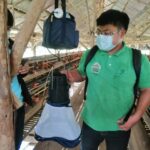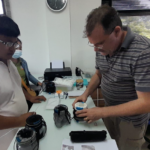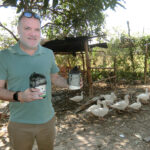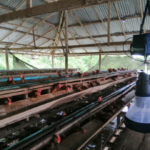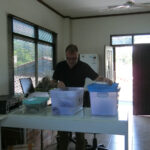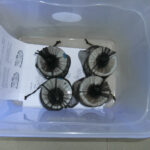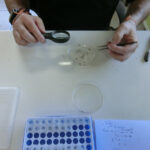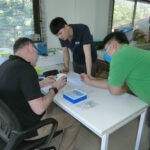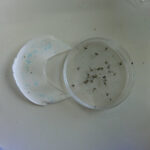Emerging arbovirus associated with bird in Laos
INTRODUCTION TO THE PROJECT
Among emerging zoonotic pathogens, mosquito-borne viruses (MBVs) are an important cause of animal and human Emerging Infectious Disease (EIDs) worldwide. Most mosquito-borne pathogens circulate between wild vertebrate animals and mosquitoes, but globalisation is favouring infection via spillover from these enzootic cycles to the human population.
Birds are natural reservoirs for some MBVs such as Japanese Encephalitis virus (JEV) and West Nile virus (WNV). Their replication cycle allows the persistence in sylvatic and rural reservoirs and pose an increasing health threat to both animals and humans due to their zoonotic and epidemic potential. Lao PDR (here after Laos) as a biodiversity hot-spot in South-East Asia (SEA), allows the active circulation of mosquitoes and therefore MBVs and threatens human and animal health in both rural and urban areas.
- Dengue virus (DENV) and Japanese Encephalitis virus (JEV) are actively circulating in the country.
- Data on less known mosquito-borne flaviviruses, such as Tembusu virus (TMUV) or Chikungunya virus (CHIKV), contributed to recently described them as a potential zoonotic emerging viruses already circulating in neighbor countries
- Tembusu virus (TMUV) : a flavivirus first isolated in Culex tritaeniorhynchus in Malaysia in 1955 and belonging to the Ntaya virus group, causes severe neuropathological disorders in ducks and other avian species as well as a significant drop in egg production resulting in massive economic losses. While TMUV has been reported since the 2000’s in China, Thailand, Taiwan and Malaysia; it has not yet been reported in Laos and other countries of SEA, highlighting the lack of regional assessments. Finally, its rapid spread raises the possibility that TMUV might emerge as a zoonotic pathogen in the future.
Thus, Laos represented an ideal study site to evaluate the presence of arboviruses in mosquito’s populations, particularly those associated with bird’s fauna.
As studying MBVs in mosquitoes is challenging and time consuming :
1) To overcome these limitations, a surveillance system based on the detection of pathogen genomics’ material in mosquito’s excreta has been recently developed. The principle is based on the fact that live mosquitoes that have been offered a sugar source of food can expel excreta that can easily be tracked down on a filter paper laid at the bottom of the trap. Screening MBVs in excreta, as a first detection step, before investigation in mosquitoes.
2) This screening can be easily combined with NGS sequencing to fully characterize viruses present in the excreta.
3) Finally, linked with ecological data obtained through other programs in Laos (ANR “FutureHealthSEA”, ANR “Discovery”), the expected results allows integrative research on the ecology of MBVs giving new insights to prevent and anticipate emerging infectious disease.
In this context, we proposed an exploratory project to assess the presence of birds associated MBVs and particularly to investigate the Tembusu virus (TMUV) circulation in rural and peri-urban areas in Laos, focusing on farms and wild birds’ habitats through the deployment of modified mosquito traps (BG-Sentinel® and BG-Ro®). Three main scientific questions have be addressed:
• Evaluate MBVs diversity in Laos, mainly focusing on bird related habitats at the human-animal interface.
• Unravel the TMUV ecology in Laos, describing the potential vectors and host reservoirs.
• Identify factors associated with human-animal interface and risk of emergence.Rodolphe Hamel, Project Leader
PROJECT IN ACTION
Task 1: Setting two one-week samples collections to control the presence of digested blood excreta on the filter paper to identify who the bitten hosts are, by using COI gene screening, thus providing a preliminary overview of hosts diversity. Samples have been collected using BG-sentinel® or -Pro® traps supplied in CO2 as a bait (3D-printed modules to replace the standard way of collecting with net traps).
- Finding spots to install mosquito traps
- Installation of a mosquito trap
- Packing the collected sample for analysis
- Isolating the mosquito trapped
- Taking down the traps
- Waiting for the traps to catch mosquitoes

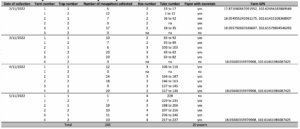
Task 2: Mosquitoes samples have be frozen immediately after collection.
- Packing
- Transporting the mosquito samples
- Freezing
Task 3: After species identification, caught mosquitoes have been sorted, homogenized in culture medium and kept frozen for subsequent confirmation of the presence of virus following primo detection in excreta.
- Tube cultures
- Processing the mosquitoes
- Mosquitoes put into culture
Task 4: All positive samples have been subsequently characterized by Sanger sequencing or NGS sequencing to confirm and identify viruses ; same for new viruses.
NEXT STEPS
- This project should not be considered as a stand-alone research but it is associated with the INGENIOUS project, led by Rodolphe HAMEL and taking place in Thailand. Indeed, both projects aim at better understanding the ecology of arboviruses in Southeast Asia and particularly those infecting the avian fauna.
- In term of trainings, the project allowed to train a Laotian PhD student who is participating. She actively participated to the sampling session and her training in molecular detection of viral RNA to implement screening in Laos we be used in her future studies.
- Finally, this exploratory project is in line with the PREZODE initiative on the prevention of zoonotic emergencies and pandemics and the results of our project will strengthen the applications to future calls initiated by PREZODE initiative.
BILAO ON THE WEB
XXXX
CONTACT
Project Leader : Rodolphe HAMEL (rodolphe.hamel@ird.fr)
Associated researchers :
Locatelli Sabrina (sabrina.locatelli@ird.fr)
MARCOMBE Sebastien (sebastienmarcombe@gmail.com)
PHAKEOVILAY Chiobouaphing (cphakeovilay@gmail.com)
Countries involved : Laos, France and Thailand


